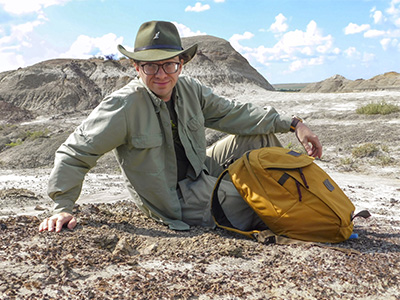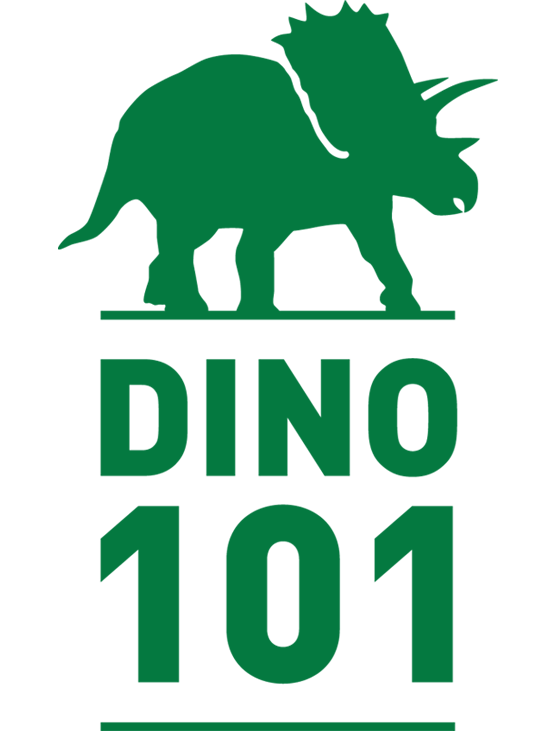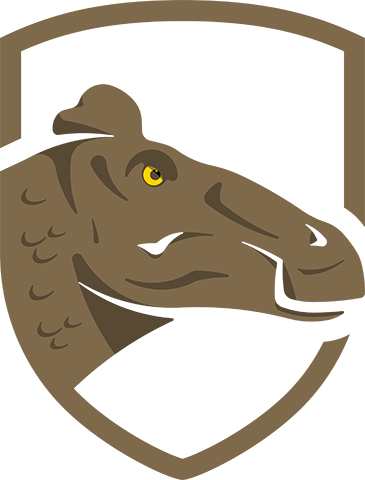’11 MSc, ’16 PhD, PDF
 Scott’s research focused on the tail anatomy of non-avian theropod dinosaurs, which includes the big carnivores like Tyrannosaurus and Albertosaurus. He performed dissections on modern animals to examine relationships between tail bone structure (which would be preserved in the fossil record) and tail musculature and flexibility. Some dinosaur tail muscles were connected to their leg bones, as well as to their hips, so his work has direct implications for assessments of dinosaur speed. Scott was also concerned with charting evolutionary trends and specializations in tail morphology across the theropod lineage. Beyond research, he was involved in the design and curation of several exhibits at the University of Alberta and various institutions in the United States, partook in multiple years of fieldwork in Dinosaur Provincial Park, Grande Prairie, Mongolia, and other places, and helped develop and deliver the Massive Open Online Course Dino 101.
Scott’s research focused on the tail anatomy of non-avian theropod dinosaurs, which includes the big carnivores like Tyrannosaurus and Albertosaurus. He performed dissections on modern animals to examine relationships between tail bone structure (which would be preserved in the fossil record) and tail musculature and flexibility. Some dinosaur tail muscles were connected to their leg bones, as well as to their hips, so his work has direct implications for assessments of dinosaur speed. Scott was also concerned with charting evolutionary trends and specializations in tail morphology across the theropod lineage. Beyond research, he was involved in the design and curation of several exhibits at the University of Alberta and various institutions in the United States, partook in multiple years of fieldwork in Dinosaur Provincial Park, Grande Prairie, Mongolia, and other places, and helped develop and deliver the Massive Open Online Course Dino 101.
Scott is originally from North Carolina and completed an undergraduate degree at Macalester College in St. Paul, Minnesota. His undergrad research included palaeoecology assessments of Triceratops-tooth-rich microsites in the Lance Formation of Wyoming, an evaluation of the relationship between foot size (relative to body mass) and habitat preference based on footprints of present African megafauna measured on the Serengeti Plain of Tanzania, and a senior honors project on the Ediacaran (Precambrian) fauna of the Boston Basin. Scott completed a MSc and then PhD with Specialization in Systematics and Evolution in 2011 and 2016, respectively, at the University of Alberta. He stayed on as a Postdoctoral Fellow until becoming an assistant professor at the College of Charleston and head curator of its Mace Brown Museum of Natural History in South Carolina.
LAB-RELATED PUBLICATIONS
Holmes, R.B., Persons, W.S., Rupal, B.S., Qureshi, A.J., and Currie, P.J. 2020. Morphological variation and asymmetrical development in the skull of Styracosaurus albertensis. Cretaceous Research 107: 104308. DOI: 10.1016/j.cretres.2019.104308
Persons, W.S., Currie, P.J., and Erickson, G.M. 2020. An older and exceptionally large adult specimen of Tyrannosaurus rex. Anatomical Record 303(4): 656–672. DOI: 10.1002/ar.24118
Persons, W.S. and Currie, P.J. 2020. The anatomical and functional evolution of the femoral fourth trochanter in ornithischian dinosaurs. Anatomical Record 303(4): 1146–1157. DOI: 10.1002/ar.24094
Persons, W.S. and Currie, P.J. 2019. Feather evolution exemplifies sexually selected bridges across the adaptive landscape. Evolution 73: 1686–1694. DOI: 10.1111/evo.13795
Stettner, B., Persons, W.S., and Currie, P.J. 2018. A giant sauropod footprint from the Nemegt Formation (Upper Cretaceous) of Mongolia. Palaeogeography, Palaeoclimatology, Palaeoecology 494: 168–172. DOI: 10.1016/j.palaeo.2017.10.027
Bell, P.R., Campione, N.E., Persons, W.S., Currie, P.J., Larson, P.L., Tanke, D.H., and Bakker, R.T. 2017. Tyrannosauroid integument reveals conflicting patterns of gigantism and feather evolution. Biology Letters 13: 20170092. DOI: 10.1098/rsbl.2017.0092
Persons, W.S. and Currie, P.J. 2017. The functional origin of dinosaur bipedalism: Cumulative evidence from bipedally inclined reptiles and disinclined mammals. Journal of Theoretical Biology 420: 1–7. DOI: 10.1016/j.jtbi.2017.02.032
Ruxton, G., Persons, W.S., and Currie, P.J. 2017. A continued role for signaling functions in the early evolution of feathers. Evolution 71: 797–799. DOI: 10.1111/evo.13178
Persons, W.S. and Currie, P.J. 2016. An approach to scoring cursorial limb proportions in carnivorous dinosaurs and an attempt to account for allometry. Scientific Reports 6: 19828. DOI: 10.1038/srep19828
Xing, L.D., McKellar, R.C., Xu, X., Li, G., Bai, M., Persons, W.S., Miyashita, T., Benton, M.J., Zhang, J.P., Wolfe, A.P., Yi, Q.-R., Tseng, K.-W., Ran, H., and Currie, P.J. 2016. A feathered dinosaur tail with primitive plumage trapped in mid-Cretaceous amber and its implications for the evolution of feathers. Current Biology 26(24): 3352–3360. DOI: 10.1016/j.cub.2016.10.008
Persons, W.S. and Currie, P.J. 2015. Bristles before down: a new perspective on the functional origin of feathers. Evolution 69(4): 857–862. DOI: 10.1111/evo.12634
Persons, W.S., Funston, G.F., Currie, P.J., and Norell, M.A. 2015. A possible instance of sexual dimorphism in the tails of two oviraptorosaur dinosaurs. Scientific Reports 5: 9472: DOI: 10.1038/srep09472
Funston, G.F., Persons, W.S., Bradley, G.J., and Currie, P.J. 2015. New material of the large-bodied caenagnathid Caenagnathus collinsi from the Dinosaur Park Formation of Alberta, Canada. Cretaceous Research 54: 179–187. DOI: 10.1016/j.cretres.2014.12.002
Persons, W.S. and Currie, P.J. 2014. Duckbills on the Run: The Cursorial Abilities of Hadrosaurs and Implications for Tyrannosaur-Avoidance Strategies. In Eberth, D.A. and Evans, D.C. (editors), Hadrosaurs (pp. 449–458). Indiana University Press.
Persons, W.S., Currie, P.J., and Norell, M.A. 2014. Oviraptorosaur tail forms and functions. Acta Palaeontologica Polonica 59: 553–567 DOI: 10.4202/app.2012.0093
Xing, L.D., Persons, W.S., Bell, P.R., Xu, X., Zhang, J.-P., Miyashita, T., Wang, F.-P., and Currie, P.J. 2013. Piscivory in the feathered dinosaur Microraptor. Evolution 67(8): 2441–2445. DOI: 10.1111/evo.12119
Persons, W.S. and Currie, P.J. 2013. Dragon tails: Convergent caudal morphology in winged archosaurs. Acta Geologica Sinica 86: 1402–1412. DOI: 10.1111/1755-6724.12009
Xing, L.D., Bell, P.R., Ji, S., Ji, Q., Miyashita, T., Persons, W.S., Burns, M.E., and Currie, P.J. 2012. Abdominal contents from two large Early Cretaceous compsognathids (Dinosauria: Theropoda) demonstrate feeding on confuciusornithids and dromaeosaurids. PLOS ONE 7(8): e44012. DOI: 10.1371/journal.pone.0044012
Persons, W.S. and Currie, P.J. 2011. Dinosaur speed demon: the caudal musculature of Carnotaurus sastrei and implications for the evolution of South American abelisaurids. PLOS ONE 6(10): e25763. DOI: 10.1371/journal.pone.0025763
Persons, W.S. and Currie, P.J. 2011. The tail of Tyrannosaurus: reassessing size and locomotive importance of the M. caudofemoralis in non-avian theropods. Anatomical Record 294: 119–131. DOI: 10.1002/ar.21290
OTHER LINKS
Website: http://scottpersons.org/



